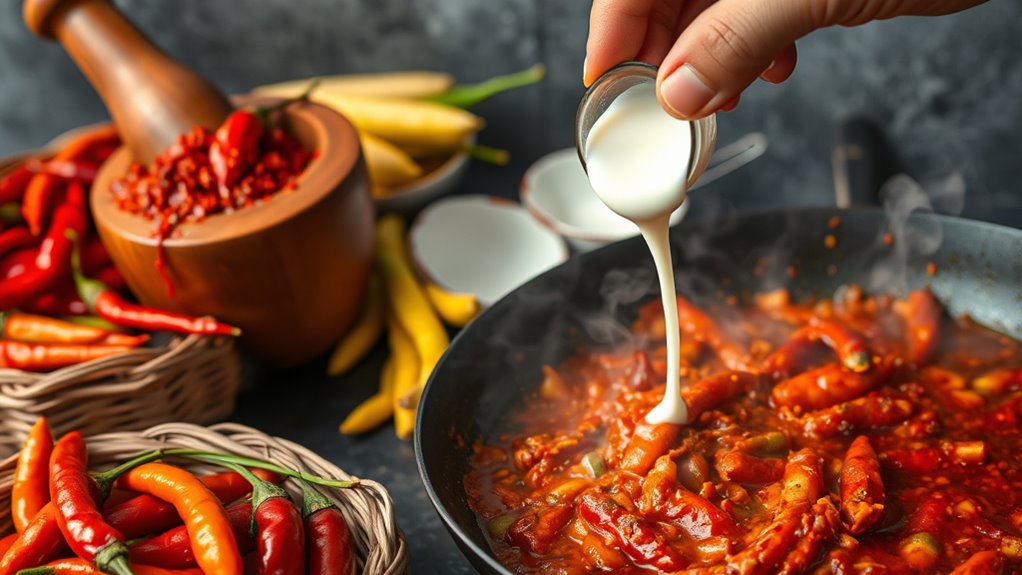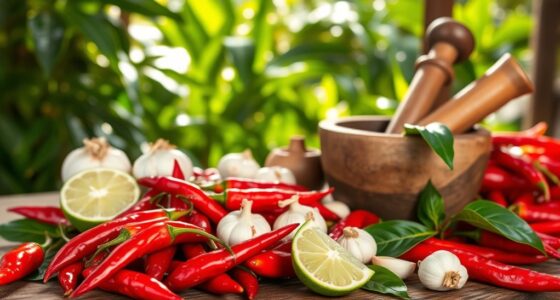To master spice and heat in Indonesian cooking, explore regional chili varieties like cayenne and bird’s eye for authentic heat levels. Develop your skill with traditional spice blends such as bumbu and sambal to build flavor layers. Adjust chili amounts to control spiciness, balancing aroma and heat for each dish. Using the right tools helps prepare spices effectively. Keep experimenting with these techniques, and you’ll uncover the secrets to achieving truly vibrant Indonesian flavors.
Key Takeaways
- Choose regional chili varieties like cayenne or bird’s eye to achieve authentic heat levels and flavor profiles.
- Master traditional spice blends (bumbu) to balance heat, aroma, and depth in Indonesian dishes.
- Experiment with chili quantities and spice combinations to customize spiciness and enhance flavor complexity.
- Understand regional preferences to adapt heat and spice usage for authentic or signature dishes.
- Use quality tools and proper storage to maintain spice potency and improve precision in spice preparation.

Indonesian cuisine is renowned for its vibrant flavors, where spice and heat play a central role in creating memorable dishes. To truly master this culinary tradition, you need to understand the importance of regional chili varieties. Indonesia’s vast archipelago offers a wide array of chili peppers, each bringing its own level of heat and unique flavor profile. For example, the fiery Cayenne is often used in the eastern regions, while the smaller, intensely pungent chili, known locally as cabai rawit or bird’s eye chili, is a staple in many dishes across Java and Sumatra. These regional chili varieties influence not only the dish’s spiciness but also its aroma and overall character. Picking the right chili for the right recipe allows you to control the heat level and accentuate the dish’s authentic flavor.
Choosing regional chilies like bird’s eye or Cayenne enhances Indonesian dishes with authentic heat and flavor.
In addition to regional chili varieties, mastering traditional spice blends is pivotal in Indonesian cooking. These blends, often called bumbu, are carefully crafted mixtures of spices that form the backbone of countless dishes. You might find a simple blend of turmeric, coriander, and garlic, or more complex mixes that include lemongrass, galangal, and kaffir lime leaves. Incorporating these blends properly requires a good understanding of their role in balancing heat, aroma, and flavor. For example, sambal, a popular chili paste, combines crushed chili, shallots, garlic, and sometimes sugar and lime juice, creating a versatile condiment that enhances everything from grilled meats to rice dishes. Learning how to prepare and use these spice blends allows you to layer flavors and build depth in your cooking.
Furthermore, understanding the regional differences in spice usage can elevate your dishes. Northern Indonesian cuisine often favors milder, aromatic flavors, while the more spicy and pungent dishes come from the eastern and western parts of the country. By exploring these regional influences, you can adapt recipes and develop your own signature style. When you combine the right chili variety with the appropriate spice blend, you create a harmonious balance of heat, aroma, and flavor that is quintessentially Indonesian.
You don’t have to be a professional chef to appreciate the nuances of Indonesian spices. With a little experimentation—adjusting chili levels and mixing traditional spice blends—you’ll gain confidence in controlling heat and flavor. This mastery not only enhances your dishes but also immerses you deeper into Indonesia’s rich culinary heritage. Additionally, paying attention to gear and equipment such as quality knives and proper storage containers can improve your spice preparation process. Whether you’re making a fiery sambal or a fragrant curry, understanding regional chili varieties and traditional spice blends is your key to unraveling the true essence of Indonesian cooking.
Frequently Asked Questions
How Do I Adjust Spice Levels for Sensitive Palates?
To adjust spice levels for sensitive palates, start with mild flavor adjustments by reducing the amount of chili or spice used in your dishes. You can also balance heat by adding ingredients like coconut milk, yogurt, or sugar, which mellow out the spiciness. Taste as you go, and gradually increase spice only if desired, ensuring the dish remains flavorful without overwhelming sensitive tastes.
What Are Traditional Indonesian Spices Not Commonly Found Elsewhere?
You might think Indonesian cuisine is just chili and turmeric, but it offers unique spice blends and indigenous herbs like kemiri (candlenuts), kunyit (turmeric), and daun salam (Indonesian bay leaf). These spices create complex flavors not commonly found elsewhere. Once you explore these authentic ingredients, you’ll appreciate how they elevate dishes with rich, aromatic profiles, giving your cooking an unmistakably Indonesian touch.
How Long Does It Take to Develop Authentic Indonesian Spice Flavors?
It typically takes several weeks to a few months for authentic Indonesian spice flavors to fully develop through spice aging and flavor maturation. During this time, the spices deepen in complexity, blending their aromatic and heat elements. To speed up the process, store your spices in airtight containers away from light and heat, and periodically toast or grind them. Patience is key to achieving that rich, layered Indonesian flavor.
Can Spice and Heat Be Added During Different Cooking Stages?
Yes, spice and heat can be added during different cooking stages to influence flavor and heat intensity control. You should consider the timing of spice addition—adding spices early develops deeper flavors, while adding them later preserves freshness and brightness. Adjust the heat level gradually by controlling when and how much spice you add, allowing you to balance aroma, flavor, and heat to suit your taste and the dish’s needs.
Are There Regional Variations in Spice Usage Across Indonesia?
Imagine walking through Indonesia’s vibrant markets, where the air hums with diverse spice aromas. You’ll notice regional spice differences, from the fiery sambal in Sumatra to the sweet, fragrant cloves in Maluku. Cultural flavor influences shape these choices, reflecting local traditions and ingredients. Your culinary journey reveals how each region’s unique spice palette weaves a rich tapestry, making Indonesian cuisine a mesmerizing mosaic of flavors that tell stories across the islands.
Conclusion
So, now that you’ve mastered Indonesian’s fiery secrets, don’t be surprised if your friends start sweating just from your cooking. Remember, a little spice goes a long way—unless you’re aiming for tears and tears alone. Keep fanning those flames, and soon you’ll be the reigning heat champion. Just don’t blame me when your taste buds start demanding a vacation—they’re not used to this level of fire, after all. Happy spicy adventures!









